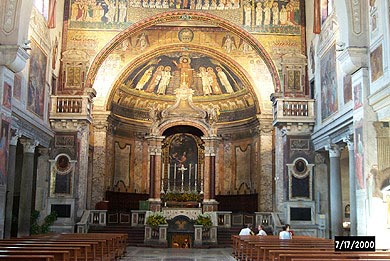| Back at the hotel, we had one more walking
tour to take that day. It was 5 O'clock in
the afternoon, and we wanted to visit S.
Prassede, which Judy described as
"A Medieval Garden of Paradise."
(JT103-108) The story goes that Prassede and her
Sister Prudenziana were sisters and daughters of
a Roman senator named Prudens, that met St. Peter
on his first visit to Rome. The sisters were
converted to Christianity. Later they played host
to Peter and gave him refuge during the
persecution. Now the church claim neither
daughter ever existed. But here is the Prassede
Basilica, tucked away in a side street which was
very difficult to find. When we first found it,
it was closed for siesta. Now at 5 PM, we had an
hour before it's 6 O'clock closing. |
|
 |
| The interior of
S. Prassede. |
|